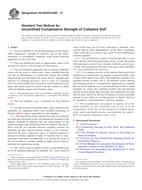Potřebujeme váš souhlas k využití jednotlivých dat, aby se vám mimo jiné mohly ukazovat informace týkající se vašich zájmů. Souhlas udělíte kliknutím na tlačítko „OK“.
ASTM D2166/D2166M-13
Standard Test Method for Unconfined Compressive Strength of Cohesive Soil
Automaticky přeložený název:
Standardní zkušební metoda pro neomezené pevnosti v tlaku soudržných půdy
NORMA vydána dne 15.5.2013
Informace o normě:
Označení normy: ASTM D2166/D2166M-13
Poznámka: NEPLATNÁ
Datum vydání normy: 15.5.2013
Kód zboží: NS-19490
Počet stran: 7
Přibližná hmotnost: 21 g (0.05 liber)
Země: Americká technická norma
Kategorie: Technické normy ASTM
Kategorie - podobné normy:
Zemní práce. Hloubicí práce. Budování základů. Podzemní práce
Anotace textu normy ASTM D2166/D2166M-13 :
Keywords:
cohesive soil, sensitivity, strain-controlled loading, strength, stress-strain relationships, unconfined compression, ICS Number Code 93.020 (Earth works. Excavations. Foundation construction. Underground works)
Doplňující informace
| Significance and Use | ||||||||||||||||||||||||||||
|
5.1 The primary purpose of the unconfined compression test is to quickly obtain a measure of compressive strength for those soils that possess sufficient cohesion to permit testing in the unconfined state. 5.2 Samples of soils having slickensided or fissured structure, samples of some types of loess, very soft clays, dry and crumbly soils and varved materials, or samples containing significant portions of silt or sand, or both (all of which usually exhibit cohesive properties), frequently display higher shear strengths when tested in accordance with Test Method D2850. Also, unsaturated soils will usually exhibit different shear strengths when tested in accordance with Test Method D2850. 5.3 If tests on the same sample in both its intact and remolded states are performed, the sensitivity of the material can be determined. This method of determining sensitivity is suitable only for soils that can retain a stable specimen shape in the remolded state. 1.1 This test method covers the
determination of the unconfined compressive strength of cohesive
soil in the intact, remolded, or reconstituted condition, using
strain-controlled application of the axial load.
1.2 This test method provides an approximate value of the strength of cohesive soils in terms of total stresses. 1.3 This test method is applicable only to cohesive materials which will not expel or bleed water (water expelled from the soil due to deformation or compaction) during the loading portion of the test and which will retain intrinsic strength after removal of confining pressures, such as clays or cemented soils. Dry and crumbly soils, fissured or varved materials, silts, peats, and sands cannot be tested with this method to obtain valid unconfined compression strength values. 1.4 This test method is not a
substitute for Test Method D2850.
1.5 All observed and calculated values shall conform to the guidelines for significant digits and rounding established in Practice D6026, unless superseded by this standard. 1.5.1 The procedures used to specify how data are collected/recorded and calculated in this test method are regarded as the industry standard. In addition, they are representative of the significant digits that should generally be retained. The procedures used do not consider material variation, purpose for obtaining the data, special purpose studies, or any considerations for the user's objectives; and it is common practice to increase or reduce significant digits of reported data to commensurate with these considerations. It is beyond the scope of this test method to consider significant digits used in analysis methods for engineering design. 1.6 The values stated in either SI units or inch-pound units are to be regarded separately as standard. The values stated in each system may not be exact equivalents; therefore, each system shall be used independently of the other. Combining values from the two systems may result in non-conformance with the standard. 1.6.1 The gravitational system of inch-pound units is used when dealing with inch-pound units. In this system, the pound (lbf) represents a unit of force (weight), while the unit for mass is slugs. The rationalized slug unit is not given, unless dynamic (F = ma) calculations are involved. 1.6.2 It is common practice in the engineering/construction profession to concurrently use pounds to represent both a unit of mass (lbm) and of force (lbf). This implicitly combines two separate systems of units; that is, the absolute system and the gravitational system. It is scientifically undesirable to combine the use of two separate sets of inch-pound units within a single standard. As stated, this standard includes the gravitational system of inch-pound units and does not use/present the slug unit for mass. However, the use of balances or scales recording pounds of mass (lbm) or recording density in lbm/ft3 shall not be regarded as nonconformance with this standard. 1.7 This standard does not purport to address all of the safety problems, if any, associated with its use. It is the responsibility of the user of this standard to establish appropriate safety and health practices and determine the applicability of regulatory limitations prior to use. |
||||||||||||||||||||||||||||
| 2. Referenced Documents | ||||||||||||||||||||||||||||
|
Doporučujeme:
Aktualizace technických norem
Chcete mít jistotu, že používáte pouze platné technické normy?
Nabízíme Vám řešení, které Vám zajistí měsíční přehled o aktuálnosti norem, které používáte.
Chcete vědět více informací? Podívejte se na tuto stránku.




 Cookies
Cookies
